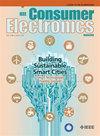一种改进的低压弱电网光伏电池集成系统有功功率注入与电能质量提高控制策略
IF 4.3
2区 计算机科学
Q1 ENGINEERING, ELECTRICAL & ELECTRONIC
引用次数: 0
摘要
本文提出了一种改进的控制策略,以提高低压弱电网光伏电池集成系统的有功功率注入和电能质量。该方法有效地估计了正弦和非正弦参考量,从而同时改善了有功功率注入和多个PQ补偿。该系统通过计算基于基基电压和负载电流分量的参考功率和负载功率,并采用基于功率角和电压增益的互连变换器的最优额定值,使变换器容量最大化,高效可靠地实现多种功能。光伏系统通过带有mpt - drop集成控制器的升压转换器连接到直流母线,确保在缺电时提取最大功率,在缺电时充当下垂控制器。这种配置通过调节直流母线电压,实现交流和直流之间的无缝双向功率流。与传统控制器提高PQ或可再生集成,导致转换器利用率降低和成本增加不同,该策略优化转换器额定,提高利用率和效率,并显着降低成本。该系统在原型实验室测试平台上进行了验证,实验结果表明该系统在各种操作条件下都具有出色的性能。硬件测试结果证实了该系统在谐波抑制、功率因数改善、无功补偿以及补偿不同条件下非线性和高感性负载引起的不平衡效应等方面的有效性。本文章由计算机程序翻译,如有差异,请以英文原文为准。
An Improved Control Strategy for Active Power Injection and Power Quality Enhancement in a Low-Voltage Weak-Grid Integrated PV and Battery System
This article presents an improved control strategy for enhancing active power injection and power quality (PQ) in a low-voltage weak-grid integrated PV and battery system (LWPB). The proposed method effectively estimates both sinusoidal and non-sinusoidal reference quantities, thereby improving active power injection and multiple PQ compensations simultaneously. By computing reference and load power based on fundamental voltage and load current components, and employing an optimal rating for the interlinking converter based on power angle and voltage gain, the system maximizes converter capacity to perform multiple functions efficiently and reliably. The PV system is connected to the DC bus through a boost converter with an MPPT-droop integrated controller, ensuring maximum power extraction during power deficits and acting as a droop controller during power surpluses. This configuration enables seamless bidirectional power flow between AC and DC by regulating the DC bus voltage. Unlike conventional controllers that enhance either PQ or renewable integration, leading to reduced converter utilization and higher costs, this strategy optimizes converter rating, improves utilization and efficiency, and significantly reduces costs. The proposed system was validated using a prototype laboratory testbed, with experimental results demonstrating exceptional performance across a wide range of operating conditions. The hardware results confirm the system’s effectiveness in harmonic suppression, power factor improvement, reactive power compensation, and compensation for unbalanced effects caused by non-linear and highly inductive loads under different conditions.
求助全文
通过发布文献求助,成功后即可免费获取论文全文。
去求助
来源期刊
CiteScore
7.70
自引率
9.30%
发文量
59
审稿时长
3.3 months
期刊介绍:
The main focus for the IEEE Transactions on Consumer Electronics is the engineering and research aspects of the theory, design, construction, manufacture or end use of mass market electronics, systems, software and services for consumers.

 求助内容:
求助内容: 应助结果提醒方式:
应助结果提醒方式:


